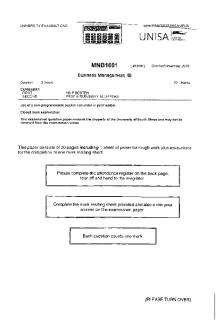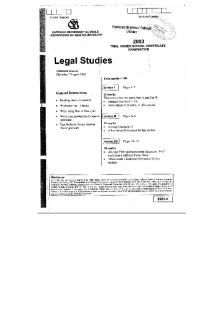KIT710-2015 - past exam paper PDF

| Title | KIT710-2015 - past exam paper |
|---|---|
| Author | Will C |
| Course | eLogistics |
| Institution | University of Tasmania |
| Pages | 6 |
| File Size | 198.6 KB |
| File Type | |
| Total Downloads | 55 |
| Total Views | 135 |
Summary
past exam paper...
Description
Student ID number: Pages : 6 Questions : 16
____________________
UNIVERSITY OF TASMANIA EXAMINATIONS FOR DEGREES AND DIPLOMAS
June 2015
KIT710 eLogistics Examiner: Dr Luke Mirowski Time Allowed: TWO (2) hours Reading Time: FIFTEEN (15) minutes
Instructions: There are a total of 120 marks available, and there are three sections to this examination: Section A is worth 40 marks and contains eight (8) questions. Section B is worth 40 marks and contains four (4) questions. Section C is worth 40 marks and contains four (4) questions. You must complete all questions in all sections – there are no optional questions. Answers to questions from sections A, B, and C must be written in your examination booklet.
-2-
KIT710 eLogistics
SECTION A Attempt an answer to ALL questions in this section. This section is worth 40 marks. Answers to each question (e.g. A1) should be around five (5) written lines in length.
A1.
Describe the components of logistics management. [5 marks]
A2.
Describe the difference between Supply Chain Value and Supply Chain Profitability (or Supply Chain Surplus). [5 marks]
A3.
From a logistics perspective, describe customer service and explain why customer service is important. [5 marks]
A4.
Describe Order Cycle Time and discuss why it important for logistics. [5 marks]
A5.
List and describe the three (3) phases of Logistics Planning. [5 marks]
A6.
List and describe the advantages and disadvantages of inventory in supply chains. [5 marks]
A7.
List and describe both the benefits and challenges of Enterprise Resource Planning (ERP) system for logistics. [5 marks]
A8.
Describe the function of cross-docking and its relationship to Just-in-Time (JIT). [5 marks]
Continued…
KIT710 eLogistics
-3-
SECTION B Attempt an answer to ALL questions in this section. This section is worth 40 marks. Answers to each question (e.g. B1) should be around ten (10) written lines in length.
B1. (a)
Describe the theory of Just in Time (JIT) for logistics. [3 marks]
(b)
List and describe the key underpinnings (or factors) of Just in Time (JIT). [4 marks]
(c)
Describe how Just in Time (JIT) applies to transportation, manufacturing and warehousing activities. [3 marks]
B2. (a)
List and describe the three (3) basic functions of warehousing. [4 marks]
(b)
List and describe three (3) factors influencing facility location. [4 marks]
(c)
Describe the relationship between warehousing and transportation. [2 marks]
B3. (a)
List and describe three (3) factors in forming supply chain relationships between customers and suppliers. [3 marks]
Continued…
-4-
(b)
KIT710 eLogistics
Describe the differences between Efficient Consumer Response (ECR) and Collaborative Planning Forecasting & Replenishment (CPFR). [4 marks]
(c)
Describe how Radio Frequency Identification (RFID) can be integrated into Vendor Managed Inventory (VMI) operations for efficiency gains. [3 marks]
B4. (a)
Compare and contrast the concept of ‘green supply chain management’ to traditional supply chain management. [3 marks]
(b)
Describe how Information, Communication and Technologies (ICTs) can enable a vision of Green Logistics in supply chains. [3 marks]
(c)
Describe how eLogistics can address the Green Logistics paradox for warehousing and transportation. [4 marks]
Continued…
KIT710 eLogistics
-5-
SECTION C Attempt an answer to ALL questions in this section. This section is worth 40 marks. Answers to each question (e.g. C1) should be around ten (10) written lines in length.
Read the following logistics case study and then attempt the four (4) questions below. Paul Murphy, president and CEO of Central Transport, had just returned from a meeting called by Sue Purdum, president and CEO of ABC Distribution. He immediately sat down and wrote the following email message to all his senior staff: I need your collective wisdom and input to help me respond to a challenge given to me by Sue Purdum of ABC Distribution. ABC, as you know, has been one of our best customers for many years. Our growth has been tied to its growth since we are one of its core carriers. As it expanded its customer base throughout Victoria and neighboring states, we have expanded our route network to meet its requirements. Our founder, John Harrison, was a personal friend of the three founders of ABC Distribution. While that personal relationship has changed with changes in both our organisations, Central Transport has maintained a partnership approach with ABC Distribution. My belief is that if it wins, we win. ABC, according to MS. Purdum, has been faced with a growing level of competition both directly and indirectly in the two small medium-size communities where its retail store customers are located. Its profit margins have narrowed, and Ms. Purdum is under pressure from her board (most of whom are descendants of the three founders) to improve ABC’s profitability. To her credit, she initiated a number of changes after she became president and CEO five years ago. According to Ms. Purdum, she has to reduce her cost-of-sales and/or improve her level of customer service to add more value to her customers. Transportation from ABC’s warehouse to its customer stores is a major part of its cost-of-sales. Also, our ability to deliver her customer’s orders in a timely and reliable manner impacts significantly ABC’s customer service. Ms. Purdum would like our senior management team to consider what we could do to help ABC remain competitive and improve its profitability. Obviously, we could reduce our transport rates by 10 percent, but that only shifts the problem to us unless we can reduce our transport operating costs by 10 percent to offset the transport rate reduction. We need to be creative and think of ourselves as a supply chain partner with ABC and its suppliers and customers.
Help Mr. Murphy develop a eLogistics proposal to respond to Ms. Purdum by answering the following questions:
Continued…
-6-
C1.
KIT710 eLogistics
What is the current state of problems in the supply chain and their implications for supply chain collaboration? [10 marks]
C2.
List and describe the potential advantages and disadvantages for the collaborative logistics perspective suggested by Mr. Murphy. [10 marks]
C3.
Recommend a logistics strategy and associated set of Information, Communication and Technologies (ICTs) to help both Central Transport and ABC improve their joint efficiency and effectiveness. [10 marks]
C4.
List and describe the barriers and motivators to the successful implementation of your eLogistics recommendation. [10 marks]
This is the end of the exam paper....
Similar Free PDFs

STAT270 - past exam paper
- 24 Pages

Past exam Paper 2018
- 23 Pages

Trial past exam paper
- 7 Pages

MA103 Past Paper Exam
- 5 Pages

2010 exam - past paper
- 25 Pages

KIT710-2015 - past exam paper
- 6 Pages

Past Exam Paper 2017-2018
- 2 Pages

2016 s2 - past exam paper
- 16 Pages

ANS333 Past exam paper 2015
- 10 Pages

SBL Past Exam Paper 2019
- 20 Pages

Criminal Law Past Exam Paper
- 16 Pages

ECO1005 exam 2018-9 - Past Paper
- 3 Pages

all india bar exam past paper
- 10 Pages

AQA 71321 QP JUN17 - Past Exam Paper
- 24 Pages

Uob past paper
- 4 Pages

Legal Studies Past paper
- 18 Pages
Popular Institutions
- Tinajero National High School - Annex
- Politeknik Caltex Riau
- Yokohama City University
- SGT University
- University of Al-Qadisiyah
- Divine Word College of Vigan
- Techniek College Rotterdam
- Universidade de Santiago
- Universiti Teknologi MARA Cawangan Johor Kampus Pasir Gudang
- Poltekkes Kemenkes Yogyakarta
- Baguio City National High School
- Colegio san marcos
- preparatoria uno
- Centro de Bachillerato Tecnológico Industrial y de Servicios No. 107
- Dalian Maritime University
- Quang Trung Secondary School
- Colegio Tecnológico en Informática
- Corporación Regional de Educación Superior
- Grupo CEDVA
- Dar Al Uloom University
- Centro de Estudios Preuniversitarios de la Universidad Nacional de Ingeniería
- 上智大学
- Aakash International School, Nuna Majara
- San Felipe Neri Catholic School
- Kang Chiao International School - New Taipei City
- Misamis Occidental National High School
- Institución Educativa Escuela Normal Juan Ladrilleros
- Kolehiyo ng Pantukan
- Batanes State College
- Instituto Continental
- Sekolah Menengah Kejuruan Kesehatan Kaltara (Tarakan)
- Colegio de La Inmaculada Concepcion - Cebu